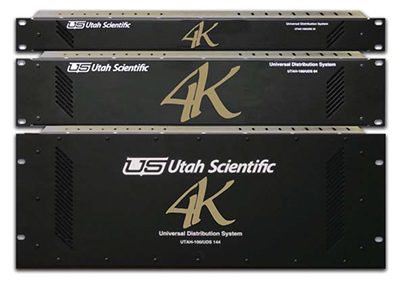Tweaking Your Routing System for UHD
JOHNSTON, IOWA—Regular readers of this column know that I have recently been writing about UHDTV and its potential applications in the terrestrial broadcast environment. Regardless of whether we actually broadcast UHD terrestrially or not, the format will have a place in the station environment. For long-tail content, UHD provides a methodology for making content more future-resistant as technology continues to evolve. Additionally, stations such as Iowa Public Television that create content have to begin considering that the terrestrial path will not be the sole delivery method and while one avenue may not support a piece of UHD content, others may.
BACKBONE INFRASTRUCTURE
With that in mind, I began looking at our facility and figuring out how we would deal with UHD content in the production environment.

Utah Scientific’s UDS router The situation is not unlike our conversion to HD. Long before we were able to broadcast in hi-def, IPTV had begun producing content in HD; likewise, I expect that IPTV will begin producing UHD content before we have the facilities to terrestrially broadcast it. However, a key difference is that other delivery mechanisms like OTT have already begun to evolve to handle UHD and the consumer hardware to display it is already being deployed.
It is always great fun to go out and look at the acquisition, production and editing systems. I think because of their direct interface to the users, they are always top of mind. Equally important, although not as sexy, is the backbone infrastructure which is why I started looking at the station’s routing facility. Our existing facility uses a Utah Scientific 400 series router with a primary matrix of 184x240.
I am a big fan of the Utah Scientific products for a number of reasons. First and foremost is that their products just work. Secondly, their customer support is excellent so when we do have the occasional problem the repair is made quickly. Of course there is their 10-year warranty and no maintenance support contracts so ongoing cost of ownership is very low. I am therefore highly motivated to try and stay with them for our UHD evolution if at all possible.
VARIATIONS TO CONSIDER
It turns out there are a few variations that I can consider. Probably the simplest would be to use dual or quad links in and out of the router, which would allow the use of the existing routing fabric with no modification to the router itself, however each UHD signal would tie up two or four crosspoints. While this is an interesting idea and would probably be acceptable for some experimentation or very limited production use, as a long-term solution, it leaves something to be desired. Most stations do not have a large number of vacant inputs and outputs in their core router.
Another potential is the wholesale replacement of the existing router with a system that is UHD-capable. This is pretty much what was done when IPTV converted to HD. The difference I see here is that the conversion to HD was revolutionary in that virtually everything was changing. We were converting from an analog facility to digital and from 4:3 aspect ratio to 16:9. It was an entirely new world!
The professional video industry's #1 source for news, trends and product and tech information. Sign up below.
I see the migration to UHD as a much more evolutionary step. Everything is still going to be digital and 16:9. The big change will be in the amount of data being moved but it will still be data.
So I took a look at the Utah Scientific UDS series of routers. The system is a single link so that each UHD signal transitions through the router on a single path. Now while the UDS is designed as a standalone router, it can be configured as a layer within the architecture of our existing 400 series. Since we’re very happy with the performance of the 400, this provides a way to migrate while maintaining our existing workflow. As I extrapolate along the evolutionary path, I can see a complete transition of our facility to UHD without the disruption and turmoil that would be caused by a wholesale replacement of the existing infrastructure.
That is not to say that there will not be challenges. In its current maximum configuration, the UDS router doesn’t appear to have the total crosspoint capacity we currently need and I expect our needs may grow. I expect larger capacity units are already being planned but the UHD environment is just beginning to develop and based on our experience, Utah Scientific is a company that focuses on helping it customers throughout the entire life of their products.
Bill Hayes it the director of engineering for Iowa Public Television. He can be reached via TV Technology.
Bill Hayes is the former director of engineering and technology for Iowa PBS and has been at the forefront of broadcast TV technology for more than 40 years. He’s a former president of IEEE’s Broadcast Technology Society, is a Partnership Board Member of the International Broadcasting Convention (IBC) and has contributed extensively to SMPTE and ATSC. He is a recipient of Future's 2021 Tech Leadership Award and SMPTE Fellow.

